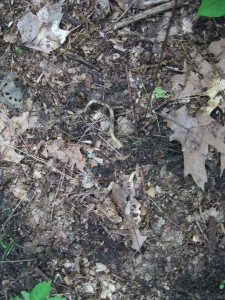I need to give the results of the small trial mentioned a month ago, when I put out eight garlic mustard plants (four small and four large) that we had pulled up early in the spring on 23 April at the Audubon Society’s Harris Sanctuary.
I spread them out on the floor of an oak woods on a patch from which I had removed the leaf litter.

Large garlic mustard plant 29 April, six days after pulling and placing on forest floor. Photo by Richard Brewer
The upper parts of the larger plants remained plump and green for several days and flowers that had not been evident when the plants were pulled appeared on the large plants. (No flowers were seen on the small plants.) Also, the tops turned upward and the roots turned down. But soon the plants began to shrivel and darken. The photo to the left is a view of one of the larger plants on 29 April. By 29 May, the plant bodies, including any flowers, had decomposed, with little structure still evident (see photo below).

Remains of large garlic mustard 29 May 2011 about one month after pulling and placing on forest floor. Photo by Richard Brewer
On the basis of this small trial, it seems unnecessary to remove plants pulled early in the spring.
By early June, most of the second-year plants growing in the woods and on the roadsides have green fruits. It seems possible that large specimens pulled or clipped and tossed on the ground from late spring on might be able to draw enough water and energy from the fleshy leaves and stems to produce viable seeds.
Certainly, many of the invasive species websites tell us that only bagging and hauling the plants away from the control site can head off seed production and dispersal. The evidence is scant, but one study (K. Solis, 1998, Restoration and Management Notes 16:223-224) seems to show that even plants pulled in the flower bud stage can produce viable seeds. A serious, well-designed study of adequate sample size would be welcome.


Thanks for the update. How can we get a study going?